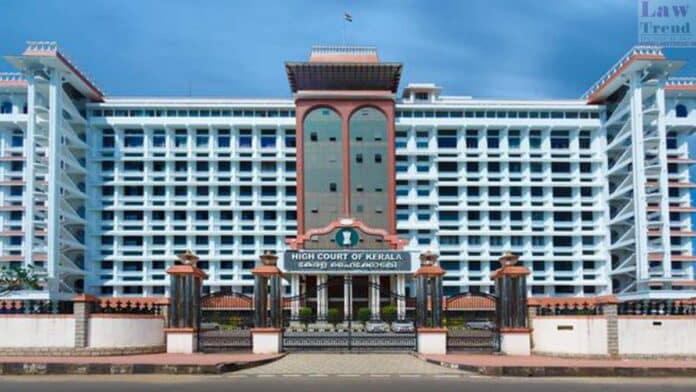The High Court of Kerala, in a significant ruling, has declared that a wife is entitled to a one-half share in a property purchased solely in her husband’s name, provided her financial contribution is established. A Division Bench comprising Justice Sathish Ninan and Justice P. Krishna Kumar held that such a transaction “partakes the character of a trust” and the husband’s contention that the title deed cannot be contradicted under Section 92 of the Evidence Act is not sustainable.
The Court allowed an appeal (Mat. Appeal No. 450 of 2018) filed by a wife (petitioner) challenging a 2018 order from the Family Court, Kollam. The Family Court had dismissed her petition (OP No. 178 of 2009) seeking a declaration of right and injunction over 8 cents of land and a two-storied building. The High Court set aside the Family Court’s order, granting the wife the declaration of 1/2 share and a consequential injunction.
Background of the Case
The petitioner (wife) married the respondent (husband) on 09.06.1974. The respondent, who began his career as a bus conductor, eventually retired as a Deputy Superintendent of Police.
The petitioner approached the Family Court, Kollam, contending that the schedule property, purchased from the Kollam District Development Authority, was acquired using funds she arranged. She claimed that out of the ₹2,00,000/- sale consideration, she contributed ₹1.53 lakh, arranged from her father and brothers, while the respondent contributed only about ₹50,000/-.
She alleged that the property was purchased in the respondent’s sole name “for namesake,” as she was a “pardanashin lady” and could not appear for the registration. She further contended that the two-storied house was subsequently constructed using the sale proceeds of her gold ornaments and timber supplied by her father.
The petitioner stated she was compelled to file the suit after the respondent pronounced talaq and attempted to bring another woman into the residence.
The respondent contested the petition, claiming the land was purchased and the building constructed “entirely from his own earnings,” supplemented by a housing loan, a KSFE chit, and a loan from his provident fund. He maintained that the timber was procured from the Government Timber Depot. While admitting her gold ornaments were sold, he claimed to have purchased new ornaments for her, which were later stolen while he was working in Kosovo.
The Family Court dismissed the petition, holding that a suit for declaration of right over immovable property purchased in the husband’s name was “not maintainable under Section 45 of the Transfer of Property Act, 1882.”
High Court’s Analysis and Findings
The High Court, in its judgment dated November 13, 2025, conducted a detailed analysis of the evidence, focusing on crucial admissions made by the respondent during a separate vigilance enquiry.
Respondent’s Admissions in Vigilance Enquiry
The Court noted that Ext.X1 file, pertaining to a preliminary enquiry against the respondent for assets disproportionate to his known income, was produced. In his statement to the vigilance officer, the respondent (a retired DySP) had made several key admissions:
- He stated the property (8.01 cents) was purchased for a sale consideration of ₹2,00,250/-.
- He admitted to receiving ₹53,000/- from the petitioner’s brother through two NRI drafts, and ₹50,000/- from another brother, for the purchase of the property.
- He stated the two-storied building was constructed during 1994-1995 for ₹4.25 lakhs.
- Crucially, he admitted that he had “sold the petitioner’s gold ornaments at Haris Jewellery, Paravur, for ₹1,60,192.50, to meet the expenses of the construction,” and had produced receipts for the same during that enquiry.
Admissions as Substantive Evidence
During the trial (as RW1), the respondent conceded he made these statements but attempted to explain “that he had given those statements only to extricate himself from the enquiry proceedings and that the statements recorded therein were not true.”
The High Court flatly rejected this explanation. “We are unable to accept such a contention,” the bench noted, adding that the explanation “is wholly inadmissible in a judicial enquiry, as accepting it would virtually amount to the Court endorsing the respondent’s own claim that he, while acting as a public servant, had acquired assets disproportionate to his bona fide income.”
Citing Sections 17, 18, 21, and 31 of the Indian Evidence Act, 1872 (corresponding to Sections 15, 16, 19, and 25 of the Bharatiya Sakshya Adhiniyam), and relying on Supreme Court precedents (Bharat Singh and another v. Mst. Bhagirathi, AIR 1966 SC 405 and Avadh Kishore Dass v. Ram Gopal and others, AIR 1979 SC 861), the Court held that admissions are “substantive pieces of evidence” that “shift the burden of proof.”
The Court found that the respondent, despite later claiming the money from his brothers-in-law were “loans” he “repaid,” had “failed to adduce any evidence to substantiate his claim.”
Testimony of Jeweller Found ‘Lacking in Credibility’
The Court also discredited the testimony of the jewellery shop proprietor (RW5), who supported the respondent’s claim of having purchased 50 sovereigns of new gold ten days after the sale. The Court found his evidence “lacking in credibility” because RW5 admitted he never mentioned this subsequent purchase to the vigilance officer and “had not issued any bill for the alleged purchase,” despite having VAT registration. The High Court found the petitioner’s contention “to be probable” that RW5 deposed falsely “under the undue influence of the respondent, a former local police officer.”
Rejection of Delay Argument
The Court dismissed the respondent’s argument that the suit lacked bona fides as it was filed 14 years after the sale. The bench held: “So long as the marital relationship subsisted, the petitioner had no occasion or reason to challenge the sale arrangement.” It noted the undisputed facts that the respondent had issued talaq intimations in 2009, which triggered the litigation.
Calculation of Share and Family Court’s Error
Based on the respondent’s own admissions in the vigilance enquiry (Ext.X1), the Court calculated the total value of the property as ₹6,25,250/- (₹2,00,250 for land + ₹4,25,000 for building). The petitioner’s contribution was established as ₹3,13,000/- (₹1,53,000 for land + ₹1,60,000 from gold), which the Court noted “is equivalent to one-half of the total value.”
The High Court held that the Family Court “erred” in dismissing the suit based on the Transfer of Property Act, stating that the petitioner’s claim “falls within the scope of Section 35 of the Specific Relief Act.”
Section 92 Evidence Act Not a Bar
The respondent argued that Section 92 of the Evidence Act (corresponding to Section 95 of BSA) barred the petitioner from contradicting the recitals in the sale deed, which was solely in his name.
The High Court rejected this contention on two grounds:
- The rule excluding oral evidence “applies only as between the parties to the instrument.”
- “That apart, in the present case, the property was purchased for the benefit of the family consisting of the husband and wife, and therefore, the transaction partakes the character of a trust. Consequently, irrespective of the recitals in the deed, the wife is entitled to seek a declaration of her right over the said property.”
The Decision
In light of these findings, the High Court allowed the appeal and set aside the order of the Family Court.
The Court declared: “the petitioner has a one-half share in the scheduled property and the building situated thereon, irrespective of what is stated in Sale Deed No. 3499/1993 of Kollam SRO.”
Noting that the petitioner resides in the building, the Court also granted a consequential injunction “restraining the respondent and persons claiming under him from forcefully interfering with the possession of the petitioner from the said land and building or from transferring or alienating her rights therein.”







